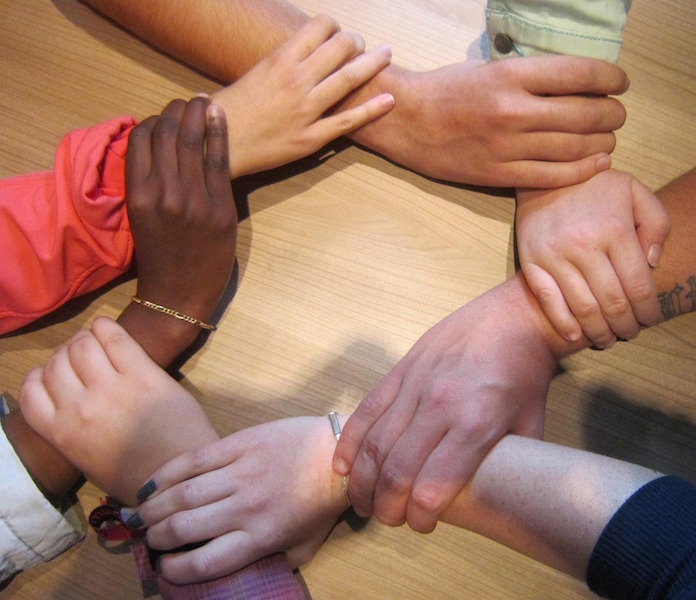
It started with a message from a friend. I’d woken – ‘on the wrong side of the head’ as I nowadays say, having slept through my ‘snooze’, new(ish) electric toothbrush really not having the desired brushing effect, and my to do list hovering heavily with 59 items to be completed by 1300.
And then came the voicemail. I’d missed the morning call in my grumpy rush to get going, and clicked ‘play’ without thinking because my head was somewhere else. It was a close friend, delivering a 2-minute monologue thanking me (amongst things) for my kindness, love and presence in his life. My heart swelled. My face beamed. My posture changed. And I felt joyous. One simple and random act of kindness had changed my whole day and my whole being. Completely and utterly. I called my friend to thank him and he said, ‘But it made me happy too, being kind and grateful not only benefits the receiver, but the giver as well’.
And this is what the research shows. When we do something good for someone else it makes us feel good too. On top of which evidence suggests that random acts of kindness create neural pathways that enhance feelings of well-being, and the flow of feel-good endorphins and mood elevating neurotransmitters.
Cut to the latter half of my day. Slightly depleted from completing (only) 47 of the 59 to do items, lost en-route to my next meet up with sat nav issues; my colleague who was meeting me there, also lost en-route (but on a pedal bike so heavily delayed), I had to smile at what a curious day it had been as I entered the school.
The Happynesshub gang were meeting with an inspirational teacher called Adrian who is delivering ground-breaking happiness and wellbeing tools to his Year 4 class in Hertfordshire. It wasn’t long before Mr Bethune got onto kindness, my topic of the day. He said he believed children are innately kind. This made me smile, because I work with young people and I do too. But it’s not just us – research backs this up. Dr Michael Tomasello’s work suggests that this kindness is not just ‘learned behavior’, but that children are ‘naturally’ cooperative from a young age. For example a 14-month old child seeing an adult struggling to open a door because of full hands will automatically attempt to help.
Adrian also talked about the ‘virtuous circle’ all too often neglected for the more common term ‘vicious cirle’, a phrase I too often use. But a virtuous circle (now added to my daily vocabulary) is defined as:
‘A recurring cycle of events, the result of each one being to increase the beneficial effect of the next’
Basically kindness is contagious. Whether you see it as a pebble creating ripples in water, or as Adrian’s ‘virtuous circle’, evidence suggests that kindness has a ‘pay-it-forward’ effect. Someone is kind to me, it makes not only them happy but me happy too. I am more likely to be kind to others, who are then more likely to be kind to the next. Meanwhile, anyone observing these kindnesses will also get positive benefits too and are more prone to passing that kindness on. So it’s a win-win situation all round.
This is what Adrian is doing in his school. His ripples are spreading wide as he inspires our next generation to live happy, healthy and inspirational lives.
As I left our meeting, I felt energised, happy and motivated to spread the good work of Mr Bethune. Adrian had given us so much of his time and shared his passion. His kindness was infectious. I had come full circle as I climbed into bed. A day starting with kindness and ending in kindness. Gratitude diary here I come!

Hi Sally, my dear friend. You are so inspirational, it makes me feel good,
I was at your low ebb yesterday, and it’s not like me as I am usually so positive, as you know.
Suddenly, broke down, realising all the tasks I have to try to get through. But thought, wait a while, let’s try , one at a time, yes. Taking it easy, got through:
Using special glue, repairing the strap of my purse, cementing. Laces to my white shoes, cementing head back onto ornament.finishing ironing, and iron tapes onto hems of 2 pair of jeans, finishing writing emails, etc etc etc.
Have a good weekend ALL and pleasant bank holiday.
Love,
Harry
Hello Harry, it’s lovely to hear you are enjoying the Happynesshub and it is inspiring you! You too at your ripe young age are a good inspiration to us all of someone who always looks on the bright side of life, and is continually active and up to something new and exciting whether it be making your violin, going for a swim in an outdoor pool or visiting the Royal Academy. Keep spreading your passions Harry and sharing your enthusiasm! Love, Sally xx
Just catching up with ” an old happiness hub,”. Whilst I am sunning myself at Riccione, on the Adriatic coast of Italy. Have been coming here every year for about 4o years. And meet u it old friends, although, naturally, over that long period, some of them are no longer with us.
Next month, going to Venezia, remember, a few years ago, Sally, you joind me there and we had a fab time, will give Fabio the manager at the bar, your good wishes again.
The sun makes my life worthwhile. As well as good company and vino.
Love
Harry
Hi Harry I am glad that you are having fun – and I am glad that you are practising your happy list! Well aware Italia, sun, good company and music are high up that list. As well as the odd tipple of vino! Have fun my friend! x